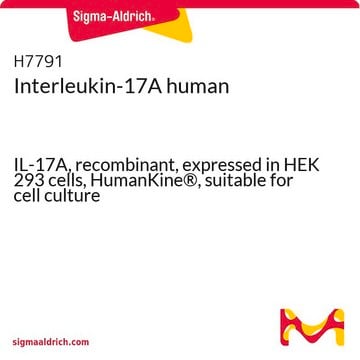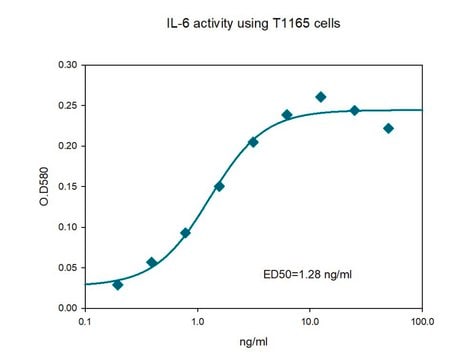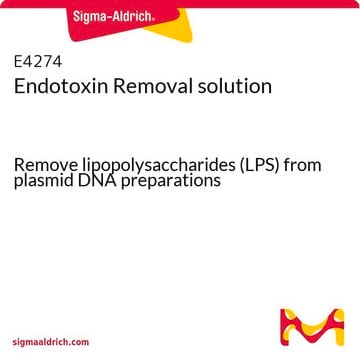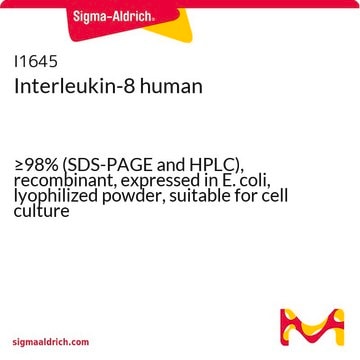I5771
Interleukin-6 Receptor Soluble Fragment human
recombinant, expressed in Sf21 cells, ≥97% (SDS-PAGE), lyophilized powder
Synonym(s):
IL-6 sR
Sign Into View Organizational & Contract Pricing
All Photos(1)
About This Item
Recommended Products
recombinant
expressed in Sf21 cells
Quality Level
Assay
≥97% (SDS-PAGE)
form
lyophilized powder
impurities
endotoxin, tested
storage temp.
−20°C
General description
Interleukin-6 is a pleotropic cytokine involved in hematopoiesis, inflammation and immune response. IL-6 is secreted by macrophages, dendritic cells and B cells, in response to TNF-α, PGDF and IL-1. The signaling by IL-6 is mediated by heterodimeric receptor, IL-6R, comprising of IL-6Rα (soluble factor) and gp130 (sometimes called IL-6Rβ). Gp130 is crucial component for downstream signal transduction. In response to IL-6, gp130 activates kinases of JAK family, STATs, MAPK and Ras proteins. IL-6R-mediated signaling is essential for normal development of T and B cells and has been implicated in many diseases such as rheumatoid arthritis, Crohn disease, sepsis, fever, systemic lupus erythematosus, osteoporosis and insulin resistance
Interleukin-6 Receptor soluble fragment specifically binds and inhibits the activity of human IL-6 in free form or when bound to cell surface receptors.
Interleukin-6 Receptor soluble fragment specifically binds and inhibits the activity of human IL-6 in free form or when bound to cell surface receptors.
Application
Interleukin-6 Receptor soluble fragment elicits a 50% increase in IL-6 activity in cell based assay at a concentration (EC50) of 1-10 ng/ml.
Physical form
Lyophilized from a 0.2 μm filtered solution in phosphate buffered saline containing 1.25 mg bovine serum albumin.
Analysis Note
The receptor mediated activity of human IL-6 receptor soluble fragment is measured by its ability to increase the IL-6 inhibition of M1 cells.
Disclaimer
Unless otherwise stated in our catalog or other company documentation accompanying the product(s), our products are intended for research use only and are not to be used for any other purpose, which includes but is not limited to, unauthorized commercial uses, in vitro diagnostic uses, ex vivo or in vivo therapeutic uses or any type of consumption or application to humans or animals.
Storage Class Code
11 - Combustible Solids
WGK
WGK 3
Flash Point(F)
Not applicable
Flash Point(C)
Not applicable
Personal Protective Equipment
dust mask type N95 (US), Eyeshields, Gloves
Certificates of Analysis (COA)
Search for Certificates of Analysis (COA) by entering the products Lot/Batch Number. Lot and Batch Numbers can be found on a product’s label following the words ‘Lot’ or ‘Batch’.
Already Own This Product?
Find documentation for the products that you have recently purchased in the Document Library.
T Gustot et al.
Gut, 54(4), 488-495 (2005-03-09)
Soluble cytokine receptors (sCRs) modulate the in vivo activity of cytokines. Deficient sCR production could participate in the pathogenesis and course of Crohn's disease (CD). The aim of the study was to examine the profile of sCRs in CD patients
David S Hong et al.
Cancer, 110(9), 1911-1928 (2007-09-13)
Interleukin-6 (IL-6) plays a major role in the response to injury or infection and is involved in the immune response, inflammation, and hematopoiesis. Its deregulation impacts numerous disease states, including many types of cancer. Consequently, modulating IL-6 may be an
Interleukin-6-type cytokines.
P B Sehgal et al.
Annals of the New York Academy of Sciences, 762, 1-14 (1995-07-21)
Oliver Dienz et al.
Clinical immunology (Orlando, Fla.), 130(1), 27-33 (2008-10-11)
Cytokines have long been known to profoundly influence the adaptive immune response by determining CD4 T cell differentiation. Although IL-6 has been initially characterized as a B cell growth factor and inducer of antibody production research from our lab and
Stefan Rose-John et al.
Journal of leukocyte biology, 80(2), 227-236 (2006-05-19)
Cytokine receptors, which exist in membrane-bound and soluble forms, bind their ligands with comparable affinity. Although most soluble receptors are antagonists and compete with their membrane-associated counterparts for the ligands, certain soluble receptors are agonists. In these cases, complexes of
Our team of scientists has experience in all areas of research including Life Science, Material Science, Chemical Synthesis, Chromatography, Analytical and many others.
Contact Technical Service







